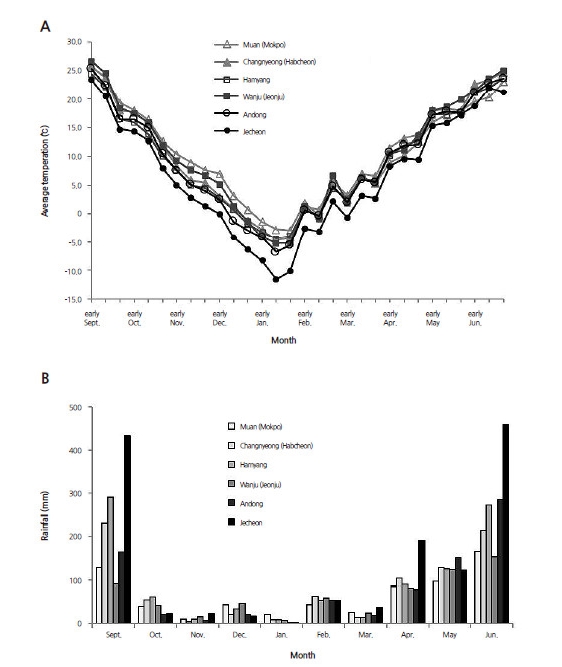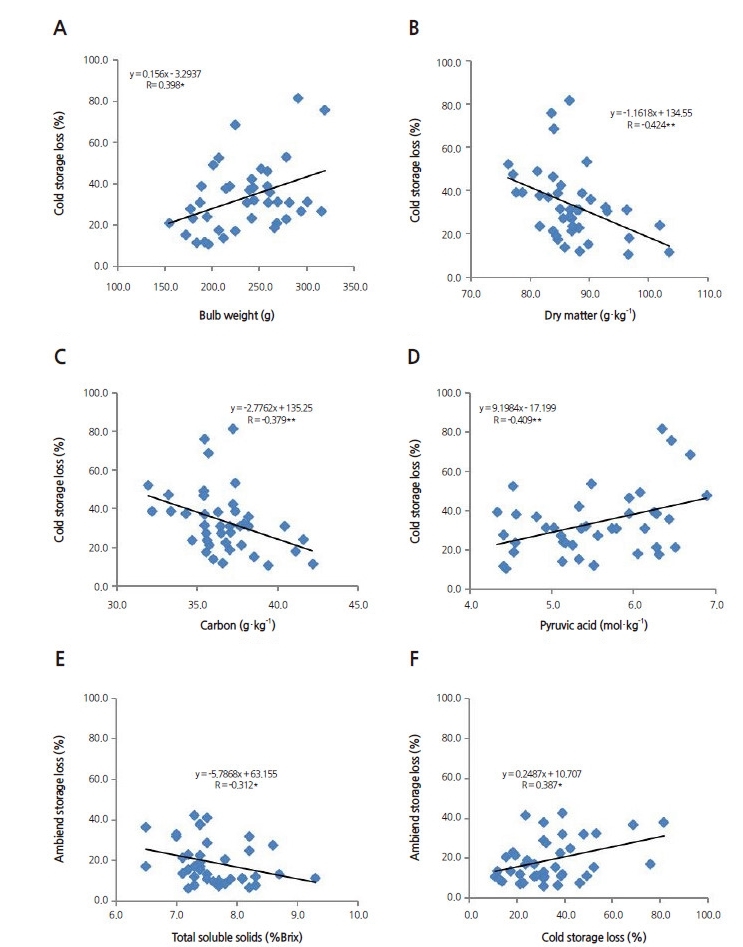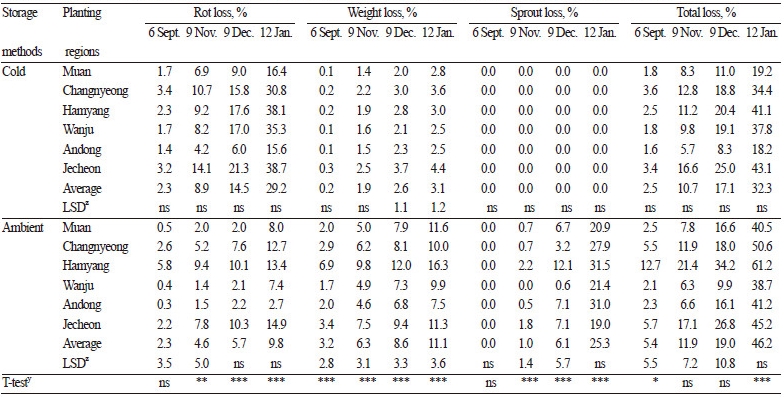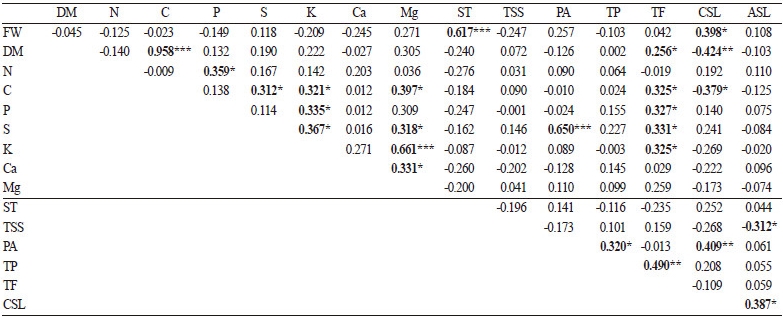Introduction
Materials and Methods
Field experiment
Soil chemical analysis
Bulb nutrient content
Data analysis
Results and Discussion
Meteorological conditions
Soil chemical properties
Mineral content, bulb characteristics and organic compound content
Storage loss in cold and ambient storage
Relationship of bulb characteristics and storage loss
Introduction
Onion (Allium cepa L.) consumption in Korea is increasing due to changes in dietary patterns and a rising awareness of their health benefits. Production has increased in line with this demand, with 1.09 million tons of bulb onions produced on 18,015 ha in Korea (Statistics[34] Korea, 2015). The onion yield in Korea is the highest worldwide, consistently achieving over 50 ton·ha-1 since 1989 (Food and Agriculture Organization[9], 2012). Onion productivity has been sustained by intensified agricultural practices; however, the gradual decline in the bulb quality of onions harvested from or stored in historic onion growing areas is one of the main issues facing the industry. In addition, many onion growers, researchers, and distributors have asserted that differences in soil type, agricultural practices, weather, and the length of continuous onion cultivation in an area could affect onion bulb quality.
The main factors influencing the quality of crops are: genotype, physical and chemical properties of the soil, weather, and preharvest and postharvest practices, such as fertilizer type, the method and rate of fertilizer application, harvest time, handling, and storage (Hornick[16], 1992). In a comprehensive report, Platinius[28] (1944) reported that late-maturing cultivars, higher temperatures, lower water supply, and organic soils increase the volatile sulfur content in onions. Their pungency increases as the leaf matures (Lee[23] and Suh, 2009; Smittle[33] and Maw, 1988). The total soluble solids (TSS) content was positively correlated with dry matter (DM; Galmarini[12] et al., 2001; Lee[20] et al., 2012), but bulb size decreased as DM increased (Mallor[24] et al., 2011). Flavonoids are one of the most prevalent phenolic compounds in onion bulbs (Williams[35] and Grayer, 2004), and were found to be positively affected by onion maturity, the process of curing, and growth in clay soils (Mogren [26]et al., 2006; Patil[27] et al., 1995).
Intermediate-day and short-day onions that can be transplanted in the fall were first introduced to the southern parts of Korea in the 1950s. Intermediate-day onions are usually stored until April when the short-day onions are harvested; thus, storage ability is considered the most important factor in onion bulb quality. Onion bulb dormancy, storability and quality are influenced by the genotype, fertilization and irrigation practices, and temperature and rainfall during the growing season (Adamicki [1], 2005; Kumar[18] et al., 2006; Lee[20] et al., 2012; Lee[21] et al., 2015), as well as the time of harvest (Bottcher[3], 1999; Wright[36] et al., 1993). Differences in weather conditions as well as the agricultural practices between onion growing regions might affect bulb and storage quality. The present study was therefore undertaken to evaluate the variability of bulb characteristics in onions from different regions, and to reveal any correlations between bulb characteristics and storage loss, which will be of benefit for the future production of quality onions.
Materials and Methods
Field experiment
This experiment was conducted in the fields of onion growers in six different counties or cities: Muan (35.0°N, 126.5°E, at an elevation of 30 m above mean sea level), Changnyeong (35.5°N, 128.5°E, 20 m elevation), Hamyang (35.5°N, 127.7°E, 150 m elevation), Wanju (36.0°N, 127.2°E, 50 m elevation), Andong (36.5°N, 128.7°E, 140 m elevation), Jecheon (36.9°N, 128.1°E, 260 m elevation). An F1 hybrid intermediate-day onion (cv. Powerball) was grown in the 2010/2011 growing season at all experimental sites. Other cultivation methods were performed according to participating farmers’ usual practices. Typically, onion seedlings were transplanted from late October to early November, and harvested from early to late June, depending on the region’s weather conditions. The average air temperature and rainfall of each region were obtained from regional weather stations. Weather information from counties without weather stations came from a neighboring county or city.
Soil chemical analysis
The surface soil (0-20 cm deep) from each experimental field was sampled before cultivation bed preparation. These samples were air-dried and used to analyze their content of nitrogen (N), organic matter (OM), sulfur (S), available phosphorus (available P), and exchangeable cations, as well as their pH and electric conductivity (EC). OM, N and S contents were measured using an elemental analyzer (vario Max, Elementar, Germany). For the available P and exchangeable cations analysis, the soils were extracted following the Morgan extractant method (McIntosh[25], 1969) and the available soil P content was measured by a spectrophotometer (UV 2450, Shimadzu, Japan), while an atomic absorption spectrophotometer (novAA 300, Analytik Jena, Germany) was used to determine the exchangeable cations. Soil pH and EC were respectively determined by a pH meter and an Orion conductivity meter (Thermo Fisher Scientific, USA), using a 5:1 deionized water:soil ratio.
Bulb nutrient content
Three replicates of plant samples were collected from approximately 3.3 m2 plots several days before the main crop was harvested. The bulb diameter and weights of ten representative bulbs were determined individually. The bulb skins were peeled and cut in half perpendicular to the growing axis, allowing the number of growing points and the number of scales to be counted. The thickness of each scale was calculated by dividing the radius of the bulb by the number of scales. After each half was cut to the growing axis, one lower part and one upper part were immediately chopped into pieces 1-2 cm3. The chopped pieces were homogenized for 1 min in a blender (Food mix HMR-505, Hanil Electric, Korea). The homogenized sample was filtered through a filter paper (No. 6, Advantec, Japan) for approximately 60 min and stored in a 15-mL capped vial at -20°C. The filtered sample was used for the analysis of total phenolics (TP), total flavonoids (TF), pyruvic acid (PA) and TSS content. The other half of the bulb was chopped into pieces approximately 1-2 cm3 and dried at 105°C to a constant weight (approximately 2 hours), and incubated at 60°C for 22 hours. The dried samples were then ground and used to analyze the mineral elements.
A 0.5 g sample of the dried and ground tissue was dissolved in concentrated H2SO4 and concentrated H2O2. Potassium (K), calcium (Ca) and magnesium (Mg) contents were measured in the dissolved samples using a novAA 300 atomic absorption spectrophotometer (Slavin[31], 1968). The P content was determined colorimetrically using the ammoniumvanadate- molybdate method at 470 nm (Gericke[13] and Kurmies, 1952). Carbon (C), N and S contents of the ground samples were measured using a vario Max elemental analyzer. TP content was measured with the Folin-Ciocalteau assay (Singleton[32] and Rossi, 1965), and expressed as mg of gallic acid equivalents (GAE) per kg on a fresh weight basis. TF content was measured with an aluminum chloride colorimetric method as described by Zhishen[40] et al. (1999), and expressed as mg of quercetin equivalents (QE) per kg on a fresh weight basis. The PA content was determined by the method of Yoo[38] et al. (1995) and calculated from a standard sodium pyruvate curve by a spectrophotometer (UV 2450, Shimadzu, Japan). TSS content was measured with a hand refractometer (Atago, PAL-1, Japan), and expressed as % Brix.
The remaining onion bulbs were divided into two 20-kg plastic boxes, with half stored in cold storage at 0±1°C and 70- 80% relative humidity, and half stored in ambient temperatures in a greenhouse. After 1.5 months, the stored onions were separated into unmarketable (rotted or sprouted) and marketable onions, and weighed to calculate percent weight loss, rotted and sprouted loss every second month. These measurements were repeated after another two months, then monthly until the end of the experiment. Storage losses were investigated until 12 January in cold storage, but until 9 December in ambient temperature storage because most onion bulbs were sprouted in January.
Data analysis
Statistical analyses of experimental data were performed using XLSTAT Pro 2013.1.01 (Addinsoft, USA). Significant differences between means were determined using Fisher’s protected least significant difference at p≤ 0.05. The Pearson coefficient (r) was calculated to assess the correlations between bulb nutrient values. Several bulb characteristics known to be highly related to storage ability were analyzed by linear regression.
Results and Discussion
Meteorological conditions
The average air temperature from September 2011 to June 2012 was lowest in Jecheon, which received almost twice as much rainfall as the other regions during the onion growing season (1,358 mm), with particularly high rainfall in September, April and June (Fig. 1). The Muan and Andong regions had the least rainfall, and Muan also had the highest average air temperatures. The higher temperatures in winter and lower in late spring seen in Muan are considered favorable for onion growth and bulb development (Brewser[5], 1997).

Fig. 1
Average temperature of ten-day intervals (A) and monthly rainfall (B) in six different regions during the growing season. Weather information from counties without weather stations came from a neighboring county or city, shown in parentheses.
Soil chemical properties
Soil EC, OM, available P, and extractable K and Mg contents were significantly different among the onion growing regions in the soil prior to planting (Table 1). The soil EC, available P and extractable K content were higher in Wanju than in other counties, while OM content highest in Hamyang. The exchangeable Mg content was highest in Changnyeong, with a value of 2.30 cmolc·kg-1. Many of the soil chemical properties exceeded the optimum ranges for bulb onion production in Korea (RDA[30], 2006); for example, the OM content was higher in Hamyang, Wanju, Andong, and Jecheon than the optimum range (25-35 g·kg-1) and the available P content exceeded the optimum range (129-168 mg·kg-1) in all regions. The optimum range of exchangeable Ca content (5.8-6.7cmolc·kg-1) was also exceeded in all regions except Jecheon. Excessive nutrient accumulation in onion-producing areas is known to cause various problems related to bulb productivity (Lee[20] et al., 2012) or bulb nutrient content (Lee[21] et al., 2015).
Table 1. Comparison of the chemical properties of soils from onion growers’ fields in six different planting regions, prior to planting.
|
Mineral content, bulb characteristics and organic compound content
The fresh weight (FW), DM, and the C, S and Mg contents of onion bulbs were significantly affected by the differences in the original location of the harvested bulbs (Table 2). The greatest bulb weights were obtained in Hamyang, followed by Wanju, Changnyeong and Andong. The highest DM and C contents were found in bulbs from Muan, followed by Hamyang, Wanju and Changnyeong. Bulb weight can be affected by planting time and density (Boyhan[4] et al., 2009; Hutton[17] and Wilson, 1986; Caruso[6] et al., 2014), soil type or the onion cropping history for a particular field (Fleming[10] et al., 1998), as well as the OM and N content of the soil (Table 1). The onions from Hamyang and Muan suggest that bulbs with a lower DM generally have a higher FW, a trend previously observed by Currah[8] and Proctor (1990). In contrast, onions from Jecheon had both a lower FW and a lower DM content, which might be caused by the weather conditions, such as the low temperature during the growing season and the high precipitation in the late bulbing stage. Similarly, Randle[29] (1997) reported that the flavor intensity of onions increases as irrigation rates decrease and the temperature rises. In addition, the DM content of an onion bulb is affected by agricultural practices such as fertilization and irrigation in the growing season, the degree of leaf drying at harvest, and the harvest time itself (Henriksen[15] and Hansen, 2001).
Table 2. Fresh weight, dry matter content, and mineral contents in the edible part of onion bulbs from growers’ fields in six different planting regions at harvest, on a fresh weight basis.
|
The diameters and the TSS, PA, TP and TF contents of bulbs were significantly different between different planting regions (Table 3). Bulbs originating from Muan had the highest number of scales, the thinnest scale thickness, and the highest TSS and TF contents, while the highest PA and TP contents were obtained in bulbs harvested in Wanju. The bulbs grown in Jecheon had the lowest PA, TP and TF contents. Coolong[7] and Randle (2003) reported that bulb pungency, estimated by PA content, and total S content increased linearly in response to increasing temperature.
Storage loss in cold and ambient storage
When placed in cold storage, the amount of storage loss was not significantly different in bulbs from the different locations, except for the weight loss investigated on 9 December and 12 January (Table 4). At ambient temperatures, however, significant differences in storage loss were observed for bulbs harvested from the different regions; almost all storage loss characteristics showed statistical differences at each time point, with the exception of rot loss on 9 December and sprouting loss on 6 September. The total storage loss in ambient storage on 9 December was the lowest in Wanju, followed by Andong, Muan and Changnyeong. Weight loss and loss due to sprouting were higher in ambient storage than in cold storage, while rot loss was lower in the ambient storage. The total loss was lower in cold storage overall, but there was no difference between the two storage systems on 9 November and 9 December.
Table 4. Storage loss of onion bulbs from growers’ fields in six different planting regions, in both in cold and ambient storage.
|
Generally a low temperature is more effective at maintaining onion bulb quality; however, Wright[37] et al. (1935) reported that different temperatures (0°C, 4.4°C and 10°C) and different humidities (65%, 80% and 90%) during a four-month storage period did not affect rot loss, although the higher storage temperatures resulted in more weight loss and increased levels of sprouting. Similarly, Kwon[19] et al. (1999) found that the rot loss of onion bulbs stored for nine months at low temperatures (2-4 °C) and at 80% relative humidity was not significantly different from onions stored under ambient temperature, while sprouting and weight loss were lower in the cold storage than the ambient storage.
Relationship of bulb characteristics and storage loss
Correlation analyses were carried out for the different postharvest and storage bulb characters in onions (Table 5). Bulb FW was positively correlated with scale thickness (r = 0.617) and cold storage loss (CSL; r = 0.398). DM content was positively correlated with C (r = 0.958) and TF (r = 0.256), while it was negatively correlated with CSL on 12 January (r = -0.424). Bulb C content was positively correlated with S (r =0.312), K (r = 0.321), Mg (r = 0.397), and TF (r = 0.325), while it was negatively correlated with CSL (r = -0.379). Bulb S content was positively correlated with K (r = 0.367), Mg (r = 0.318), PA (r = 0.650), and TF (r = 0.331). Bulb K content was positively correlated with Mg (r = 0.661) and TF (r = 0.325). TSS content was negatively correlated with ambient storage loss (ASL) on 9 December (r = -0.312). PA content was positively correlated with TP (r = 0.320) and CSL (r = 0.409), while TP content was positively correlated with TF (r = 0.490). Positive correlations among mineral contents such as P, K, Ca and Mg were similarly described in a study by Galdon[11] et al. (2008). Our results were similar to that of Lee[20] et al. (2012), who reported that TP was positively correlated with both TF and PA contents; however, our observation of no significant correlation between bulb N content and storage loss differed from their study.
Table 5. Correlation coefficient among bulb characteristics, mineral and organic contents, and storage loss.
|
CSL decreased with higher DM and C contents, while it increased with a greater bulb weight and PA content (Fig. 2). ASL was significantly correlated with CSL of bulbs from different locations, and also decreased with a higher TSS content. PA content, which has been used to evaluate the pungency of onions, is affected by genotype, soil type, S content in the soil, and fertilizer applications, but in several studies PA did not correlate with DM (Bedford[2], 1984; Hamilton[14] et al., 1997; Yoo[39] et al., 2006). This attribute might explain the negative correlation between DM and CSL, and positive correlation between pungency and CSL.

Fig. 2
Linear regression and coefficient of regression between storage loss and onion bulb characteristics. Storage losses were investigated on 12 January in cold storage and on 9 December in ambient temperature storage.
In conclusion, the yield and bulb characteristics, as well as the contents of several nutrients and antioxidant compounds such as phenolics were altered in onions grown in different regions. Storage loss at ambient, but not cold temperatures was also affected in the bulbs from different regions. CSL was correlated with the fresh and dry weights of the bulb, as well as its C and PA contents, while ASL was highly influenced by TSS. For cold storage longer than seven months in duration, this study finds that onion growers should store smaller bulbs with a higher DM content.









